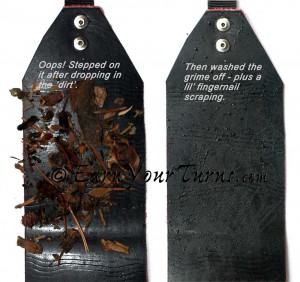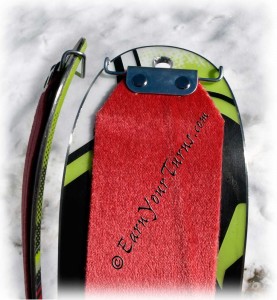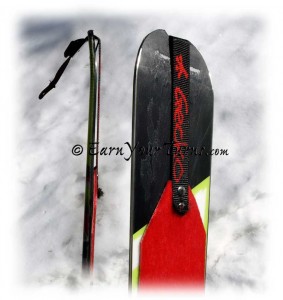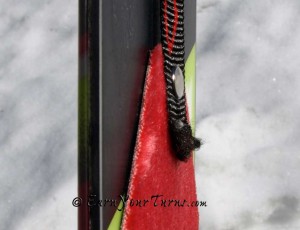As skis have gotten fatter, the criteria for judging skin glue has changed. Back in the day when today’s skinny skis felt fat, it was hard to find a climbing skin with glue that was too sticky. Stickier was always better, unless, of course, the glue was going bad and then the issue wasn’t the inability to pull skins apart after storing glue-to-glue, but the goo it left everywhere, especially on dry ski bases.
Gecko skins change the root chemical formula to get friendlier bonding properties, using a silicone based adhesive. I’m no chemistry major, but the results appear positive. Not only do the skins not stick to each other with much strength, neither do pine needles or dirt. And, should you drop them where other skins would be permanently compromised, you can simply wash them off with running water and put ’em back to work.
I stepped on the tails of the skin I have in pine needles and dirt. Classic combination for the glue contracting a terminal case of cancer. Deadly, with no known cure. Gecko’s glue appears immune though, at least to normal exposure to such danger.
Just how different the pull strength of the glue is was aptly revealed on a recent skin session. As usual I had two different skins, Gecko’s and BD’s new Ascensions on this occasion. When it came time to rip the hide, the Gecko’s took approximately 8 seconds to rip. That was actually kind of slow, but the bases of the skis were dry. That dryness exaggerated the difference in adhesive strength and slowed the pull times so that the difference is evident with the eye and a timer. BD’s Ascensions, though a mere 85mm wide and straight (with a glueless strip down the middle) took a full 18 seconds to rip the hide.
Now, in all fairness, with waxed bases the same Ascensions ripped in about 8 seconds, just like the Gecko’s did. So while taking skins off can be made easier with regular wax jobs, storing can still be a pain with fat skins. There are certainly tricks to help, but not having to deal with the excess stickiness of fat skins is the most compelling reason to consider switching to Gecko.
How do the Gecko’s stack up with the basics? The plush is mohair, which typically means better glide but it is essentially indistinguishable from some of the newer nylon skins, like BD’s Ascension, G3’s Alpinist, or BCA’s Magic Carpets. So far. I’m told that mohair skins take a while to break in before they display the superior glide they’re known for. If so, I don’t have enough time on the Gecko’s to see any difference; either that or the tail is causing drag.
Grip wise they are equal to nylon skins, holding equally well up to 30° on firm, slightly glazed snow. Neither skin felt all that solid on such a tenuous surface, but for a short stretch and a bit of technique they held. 25° sustained would be a more realistic limit, in most conditions. And, keep in mind this limit was achieved with straight skins and a fair amount of bare edge, so you may exceed these limits with wall-to-wall trimming, especially with a bit of technique thrown in.The tip loop is riveted on and fairly low profile, with a gap of ~11 mm so it can accommodate a lot of mountaineering style skis. Fat, bulbous tips would require a substitute like BD’s adjustable wire loop, or a Colltex Deep Wire loop.
The tail is a simple strip of webbing with a metal hook that you cinch tight the first time and then lock off the length. Then you can cam the hook over the tail next time around. It holds solid, but not necessarily flat, so with flat tailed skis it may add some drag. Likewise, the webbing is riveted to the tail of the skin and the corners of the webbing on the leading edge get bent over, and that does create drag – perhaps enough to make me think that’s why they don’t have much better glide than nylon skins.So toss the tail Gecko provides and get an STS tail, or G3 Alpinist tail kit. The rivets hold flat and the camming hook works much better in both cases, and then you can enjoy a simple, reliable, easy to manage skin. You’ll be psyched with the improvement in the care needed to use Gecko skins, so much so that you can focus on other things, like chuckling at your friends who can’t peel their skins apart to take another lap while you wait patiently to get moving back to the top.
Gecko Climbing Skins
MSRP: $207 – $240
Widths available: 100mm, 110mm, 120mm, 130 mm (and 140mm for splitboads)
Plus assorted accessories like tip & tail kits, skin bag, & splitboard tips and tails (L & R specific)
© 2012





20 comments
1 ping
Skip to comment form
Those look great Dostie. Looks like you have to pay for the performance though. How do you think they’d work without tails?
Author
Ya, that’s next on the list of ‘tests’ to perform.
They work fine tailless. One big plus is they pack smaller than similar fat ski skins.
Is this the same as Gecko’s ‘glueless’ skin?
Author
Yup. You notice I did NOT call it a glueless climbing skin. It uses glue, but with a different base formula. Compared to the stickiness of ‘normal’ climbing skins, especially the North American variety, it is less gluey. The only true, glueless (as in, no glue) skins I’ve tried lately are Clip Skins. Awesome to use, PITA to prepare.
PS: You didn’t watch the vid, didja?
traveling so don’t have a good connection. 🙂 Do the Geckos leave any residue on the skis? That’s what I hate most about skins…
Author
he he…a likely excuse. 😉
Residue? Not so far. It’s a bit early to know about that and I probably won’t until at least this time next season.
So what would you get as a consumer Craig- “regular” (eg BD Ascension), Gecko, or Clipskins?
Author
TeleTYSmelly,
That depends on a few things. How wide are your skis, how many days do you tour per season, and most importantly, how fed up are you with dealing with glue that’s too sticky?
If you have phat skis (waist width > 105mm), tour a lot and are fed up with overly sticky glue then I’d recommend ClipSkins or Gecko. Depends on how adept you think you’ll be at prepping the ClipSkins. The freedom you will enjoy for not having to worry about glue at all is worth the set up, but you have to believe it will or you won’t.
If you want to keep it simple, you can trim Gecko’s easier, but I recommend different tip and tail hardward (see below). I must, however, caution you that care must be taken with trimming these too. Since they’re not as sticky as normal skins, you must be careful that they don’t slip while trimming. I would be remiss if I didn’t also point out that I don’t have much time with Gecko’s and don’t know how the glue ages. If it goes bad like most glued skins do, then it depends on how soon that is, or how often you replace skis/skins anyway. And price – they are more expensive.
If glue isn’t that much of an issue for you, especially if your skis are only moderately wide (95ish mm at the waist) then price and availability may be more important. In that case I’d lean towards Colltex. Love their glue and believe it matures better than most NA skin glues – meaning it starts out sticky, looses some tackiness so it is more manageable, but maintains decent stickiness over a long time if you treat them well (cool storage, no dirt, etc.).
As for the rest of the NA skin options, based on glue alone, it is still a bit early to know. Only have 2-3 days on any of them and they’re all a bit too sticky for my preferences and I’m only using 85mm wide straight skins – usually with a glueless strip down the middle. BD has reformulated their glue and my initial impression is pretty favorable. The rest seem more or less the same and I won’t know how they mature for at least another 7 days of use, probably more.
Still think tip and tail kits make a big difference and I give the Colltex Deep Wire tip loop the best in class award, likewise for the STS tail kit, though I wish it came welded on BD (Ascension or GlideLite) skins like the tail on the new G3 Alpinist skins does.
FWIW, I’m going to replace my wife’s skins (old purple Ascensions whose glue still rocks) with ClipSkins. Not so much because the glue is too sticky (skis only 82mm wide at the waist) or she doesn’t know how to manage them in high winds on a ridge, but she gets cold hands easily and dealing with glueless skins will be waaaay simpler.
There’s one other factor to consider. Availability. BD, G3, K2 & BCA skins are available just about everywhere. Colltex, Gecko, and ClipSkins are not. If you need new skins today, I’d go with Ascension, GlideLite or Magic Carpets.
Yo, Craig:
You put your tail clips on the outside of the skin – if you put them on the adhesive side (like how they come with the skins that have them pre-attached), you wouldn’t have that drag, eh?
Author
Ooops. Obviously didn’t think that one through too well. 😉
Hi, Craig:
Just a quick but crucial note…Geckos are in fact Glue-LESS. It is not even a type of glue, it is a silicone-based adhesive. 🙂
Author
ecode,
I think you’re splitting marketing hairs. What’s the difference between an adhesive and a glue?
According to Webster an adhesive is something “prepared for adhering”, parenthetically referred to as “cement or glue.”
Glue on the other hand is “any of various strong adhesive substances.”
Glue or adhesive appear to be synonymous per Webster. So no, Gecko’s are not glue-less. Their glue simply has a different chemical formula and therefore different adhesive properties which is what I explained in this article.
Hi, I wonder, if these will work on waxless skis like Vector BC or Madshus Annum?
Author
No reason you can’t use any climbing skin with a pattern based ski. Just a matter of whether you need to or not. Patterned bases can grip steeper than 10°, but not reliably. The warmer the snow, the better they grip, and/or the more textured the snow is (fresh) the better they grip. When the snow is cold or icy – that’s when you might want skins.
I just returned from a long weekend trip and my buddy was using the Geckos. The glue (silicon based adhesive) on one of the pair dehisced from the skin and left many large patches of bare skin base. This led to failure by accumulating snow between the base of the ski and the glue. I don’t want to comment on glide or grip because I don’t have any first hand experience.
That sounds like a warranty issue, Madavis, and not the norm. Did he return them for replacement?
No, we just got back yesterday. I was wanting him to love the skins because I’ve been wanting a pair. I imagine they’ll provide good customer service and replace it, but if there wasn’t an extra pair of skins at the hut, he’d have been pretty bummed. It just makes me hesitate to buy a pair until they iron out the kinks
This is from my friend Scott who had the failure:
“They’re on the way back to Gecko, unique failure it seems, they’re sending out a new pair. I’m going to give them another shot, the intact skin worked just fine the entire trip. Just a bad batch on one skin I think. Nice folks too.”
Author
Have taken the Gecko’s out on five tours since cutting off the tail clip that I accidentally riveted to the wrong side. In my defense, I did that because I knew the rivets would prevent the adhesive from contacting the ski base in the critical tail zone. But riveting to the top side created more drag and the webbing frayed.
So I cut the tail off completely and have taken the skin on several tours since then. So far there is no need for the tail kit. This is typically true of any decent glue based climbing skin. The tail is there for when the glue inevitably goes bad, especially if you jam the tail of your skin in to the snow when doing a kick turn.
Which is exactly what I’ve been doing a lot of on recent tours. So far, the adhesive is working beautifully and the tail has not peeled back ever when jamming the tail of the skin in the snow when doing a kick turn.
[…] the skins glue-to-glue. The requirement for a special skin saver sleeve made them impractical. Gecko came out with a decent silicone-based formula, but when it got old it left a residue and started […]